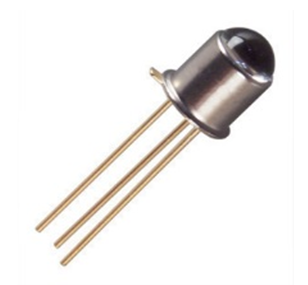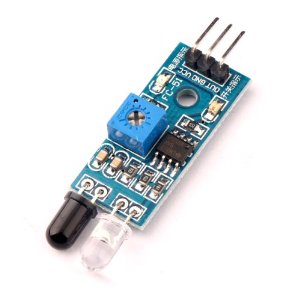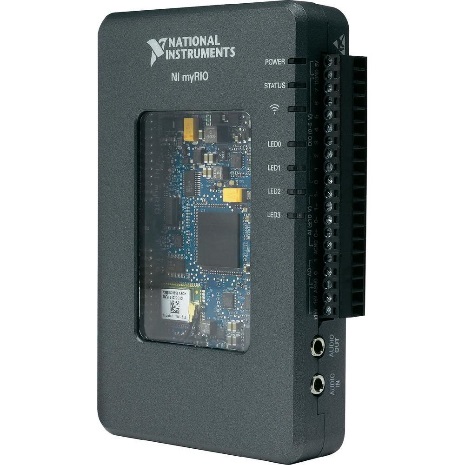-
Paper Information
- Next Paper
- Previous Paper
- Paper Submission
-
Journal Information
- About This Journal
- Editorial Board
- Current Issue
- Archive
- Author Guidelines
- Contact Us
International Journal of Internet of Things
2017; 6(2): 29-33
doi:10.5923/j.ijit.20170602.04

‘AutoHome’ an NI MyRIO Based Project
Antony Jerome, Ashra Ahmed Saied, Rithika Bekal, Santhrupthi S. M., Rahul V. A.
Department of Electrical & Electronics Engineering, St. Joseph Engineering College, Mangalore, India
Correspondence to: Antony Jerome, Department of Electrical & Electronics Engineering, St. Joseph Engineering College, Mangalore, India.
| Email: |  |
Copyright © 2017 Scientific & Academic Publishing. All Rights Reserved.
This work is licensed under the Creative Commons Attribution International License (CC BY).
http://creativecommons.org/licenses/by/4.0/

The developed prototype gives a clear idea of how energy can be used efficiently. This project is supported by the National Instrument’s prodigy MyRIO which is programmed using NI LabVIEW which is a user friendly software. Among various types of automation available, the six main systems implemented in this work are as follows: - Auto-Light, Auto-Fan, Intruder Alert, Gas Leakage Alert and the Rain sensor. All these systems are being implemented using transducers/sensors which are largely found in application in every sphere of our life. The prototype thus helps to reduce the amount of energy used per day thereby reducing wastage. It also plays a vital role in giving a central control system to the user.
Keywords: National Instruments, MyRIO, Home Automation, LabVIEW
Cite this paper: Antony Jerome, Ashra Ahmed Saied, Rithika Bekal, Santhrupthi S. M., Rahul V. A., ‘AutoHome’ an NI MyRIO Based Project, International Journal of Internet of Things, Vol. 6 No. 2, 2017, pp. 29-33. doi: 10.5923/j.ijit.20170602.04.
Article Outline
1. Introduction
- With every passing year, we see many new technologies emerging which aim to help mankind. What better way to do this than starting from your own home? According to a study done by the Environmental Protection Agency (EPA), an average person spends 87% of his life indoors. Therefore the most logical step would be to modernize the indoors. A number of software were reviewed to be used as the programming platform. Among all LabVIEW was the software that stood out. This software is very user friendly and gives a pictorial representation of the program. This makes it easy since it doesn’t call for the memorization of the entire programming syntax. LabVIEW can be interfaced via various nodules provided by the National Instruments such as NI MyRIO, NI myDAQ etc. Among this myRIO is used since it has an extra feature of being portable. The entire system is controlled using different sensors as per the purposes. Sensors are basically transducer which convert any form of physical quantity to electrical quantity and consume very less power.
2. List of Sensors
- The various types of sensors used are as follows
2.1. Photo Transistor
- The phototransistor is a semiconductor light sensor formed from a basic transistor used to convert the light incident on it into proportionate voltage values which can then be used to trigger any electrical circuit provided the ratings satisfy. They provide high levels of gain, and standard devices are low cost, these phototransistors can be used in many applications.The structure of the phototransistor is specifically optimized for photo applications. It has much larger base and collector areas than would be used for a normal transistor. These devices were generally made using diffusion or ion implantation. Photo transistors are operated in their active regime, although the base connection is left open circuit or disconnected because it is not required. The base of the photo transistor would only be used to bias the transistor so that additional collector current was flowing and this would mask any current flowing as a result of the photo-action. For operation the bias conditions are quite simple. The collector of an n-p-n transistor is made positive with respect to the emitter or negative for a p-n-p transistor.The light enters the base region of the phototransistor where it causes hole-electron pairs to be generated. This mainly occurs in the reverse biased base-collector junction. The hole-electron pairs move under the influence of the electric field and provide the base current, causing electrons to be injected into the emitter.
 | Figure 1. Phototransistor |
2.2. LM35
- LM35 is a precision IC temperature sensor with its output proportional to the temperature (in °C). The sensor circuitry is sealed and therefore it is not subjected to oxidation and other processes. With LM35, temperature can be measured more accurately than with a thermistor. It also possess low self- heating and does not cause more than 0.1°C temperature rise in still air. The operating temperature range is from -55°C to 150°C. The output voltage varies by 10mV in response to every °C rise/fall in ambient temperature. The sensor has three pins, they are Vcc, Output and Ground respectively. Vcc is rated for 5V (+35V to -2V), Output range is +6V to -1V.The LM35 series are precision integrated-circuit temperature devices with an output voltage linearly-proportional to the Centigrade temperature. The LM35 device has an advantage over linear temperature sensors calibrated in Kelvin, as the user is not required to subtract a large constant voltage from the output to obtain convenient Centigrade scaling. The LM35 device does not require any external calibration or trimming to provide typical accuracies of ±¼°C at room temperature and ±¾°C over a full −55°C to 150°C temperature range. Lower cost is assured by trimming and calibration at the wafer level. The low-output impedance, linear output, and precise inherent calibration of the LM35 device makes interfacing to readout or control circuitry especially easy. The device is used with single power supplies, or with plus and minus supplies. As the LM35 device draws only 60 μA from the supply, it has very low self-heating of less than 0.1°C in still air. The LM35 device is rated to operate over a −55°C to 150°C temperature range.
2.3. PIR Sensor
- PIR (Passive Infrared Radiation) motion sensor is a low cost device used to detect a change in its surrounding within a radius or 15 to 20 feet. This is used in many application such as in robotics and home security. Here we are making use of this sensor for an intruder alarm. PIR sensor is most commonly used to detect whether a human has moved in or out of the sensor’s range. They are small, inexpensive, consume low power, easy to use and don’t wear out.The PIR sensor itself has two slots in it, each slot is made of a special material that is sensitive to IR. When the sensor is ideal, both the slots detect the same amount of IR, the ambient amount radiated from room or wall or outdoors. When the warm body like a human or animal passes by, it first intercept one half of the PIR sensor, which causes a positive differential change between the two halves these change pulses are what is detected. The PIR sensor has three pins, i.e. Vcc (+5V), Vout and Ground.
 | Figure 2. PIR Sensor |
2.4. MQ6
- MQ6 is a simple-to-use liquefied petroleum gas (LPG) sensor, suitable for sensing LPG (composed of mostly propane and butane) concentrations in the air. The MQ-6 can detect gas concentrations anywhere from 200 to 10000ppm.This sensor has a high sensitivity and fast response time. The sensor’s output is an analog resistance. The drive circuit is very simple; all you need to do is power the heater coil with 5V, add a load resistance, and connect the output to an ADC.MQ6 has six pins of which four of them are used to fetch signals and two are used for providing heating current.
 | Figure 3. MQ6 Sensor and Pin diagram |
2.5. IR Sensor
- An IR sensor is an electronic device that emits in order to sense some aspects of the surroundings. An IR sensor can measure the heat of an object as well as detects the motion. However in this prototype, it is used only for the detection of change in surroundings that is the weather. These types of sensors measures only infrared radiation, rather than emitting it that is called as a passive IR sensor. Usually in the infrared spectrum, all the objects radiate some form of thermal radiations. These types of radiations are invisible to our eyes but can be detected by an infrared sensor. The emitter is simply an IR LED (Light Emitting Diode) and the detector is simply an IR photodiode which is sensitive to IR light of the same wavelength as that emitted by the IR LED. When IR light falls on the photodiode, the resistances and the output voltages change in proportion to the magnitude of the IR light received.
 | Figure 4. IR Sensor |
3. Software
- LabVIEW, NI’s unique platform-based approach to engineering and science applications has driven progress across a wide variety of industries. Central to this approach is LabVIEW, a development environment designed specifically to accelerate the productivity of engineers and scientists. With a graphical programming syntax that makes it simple to visualize, create, and code engineering systems, LabVIEW is unmatched in helping you reduce test times, deliver business insights based on collected data, and translate ideas into reality. LabVIEW is designed to interoperate with other software, whether alternative development approaches or open-source platforms, to ensure you can use all of the tools available to you.
4. Interfacing Module
- The MyRIO1900 is a tool you can use to teach and implement multiple design concepts with one reconfigurable I/O (RIO) device. Featuring I/O on both sides of the device in the form of MXP and MSP connectors, it includes 10 analog inputs, six analog outputs, 40 digital I/O lines, Wi-Fi, LEDs, a push button, an onboard accelerometer, a Xilinx FPGA, and a dual‐core ARM CortexA9 processor. You can program the myRIO1900 with LabVIEW or C. This Wi-Fi-enabled version allows for fast and easy integration into remote embedded applications. With its onboard devices, seamless software experience, and library of courseware and tutorials, the myRIO1900 provides an affordable tool that helps students and educators complete real engineering projects in one semester.
 | Figure 5. NI MyRIO module |
5. Operation
5.1. Auto Fan
- The automatic temperature control system comprises of a LM35 transducer which acts an input to the system and 12V DC fan which is the load. LM35 is a temperature sensor which gives a voltage output corresponding to the temperature of its surrounding taking 27°C as the normal room temperature i.e. its output is analogue. The fan is driven using BC 547 transistor. With every °C increment in temperature the speed of the fan is calibrated accordingly to give an ambient temperature. Manual switch is also provided.
5.2. Auto Lights
- A lot of unnecessary energy wastages occurs at our homes due to our lighting systems. The automatic lux control system takes in values from a photo transistor which detects the luminance of its surrounding. The sensor gives analogue output. Normal days light is found to be 300 to 315 lux. Thus the output of the system, which are 6V bulbs are controlled by calibrating the output of the phototransistor which gives an output voltage of 5V at normal day light. Amplification of the signals from myRIO is done using ULN2003 Darlington pair IC. So with decreasing lux/voltage the input to the bulbs is calibrated to give normal daylights experience. Manual switch is also provided.
5.3. Intruder Alert
- The PIR sensor senses the infrared radiation (heat energy) given out from our bodies. Thus when the PIR sensor is placed at the entrance of the house and activated during the night, any human presence is detected as a result of the radiation sensed. The Vcc pin of the sensor is connected to 5V supply and the ground is connected to the negative terminal of the supply. The sensor gives a digital output at Vout which is connected to any one of the digital pin of myRIO. A digital output 1 (high) from the sensor means there is an intruder at the entrance. This signal will be sent to the module and the module will give the output to the buzzer.
5.4. Gas Leakage Detection
- Some of the most fatal fire mishaps occur due to leakage of cooking gas. Gas leakage requires quick detection after which immediate actions have to be taken to control the leak. MQ6 sensor is used for this purpose. Whenever there is a leakage, a signal is sent to myRIO which then sends a signal to a buzzer.
5.5. Interactive Laundry Line
- Clothes are generally dried in the open air, but this possess a problem if it starts raining all of a sudden. Thus a mechanism has to be put in place to immediately sense rain and move the laundry line to a covered area. Such a mechanism is being implemented using the IR sensor. The sensor’s transmission and receiving section is placed on either side of a transparent glass plate on the roof. The light intensity from the IR transmitter through the plate during normal sunny days is different from that to when it is raining. Water changes the total internal reflection level. The voltage from the photodiode is calibrated for the two cases and thus the laundry line can be moved through a string and motor arrangement. Motor used is a 5V PMDC for the prototype which is driven using L293D H-Bridge which is also used for controlling the direction of rotation of the motor. Once the laundry line is moved to a closed environment it can be brought back to its normal location after the rains have stopped using a manual switch.
5.6. Sun Roof
- An automotive sunroof is a fixed or operable (venting or sliding) opening in a roof which allows light and/or fresh air to enter the room. Sunroofs are either manually operated or motor driven, and are available in many shapes, sizes and styles.Typically the sunroof can be controlled manually by a switch but this is dangerous in scenarios where is may start raining all of a sudden. Hence, in our prototype we have used to rain sensor to send a signal to the motors driving the sunroof open and close such that when it starts raining the roof, if open, automatically closes thereby eliminating the need for human intervention and delay.When it starts to rain, the intensity of IR reaching the photodiode placed on the opposite side of the glass plate changes due to the phenomenon of total internal refraction. Thus a signal is send to myRIO which thereby sends a signal to the motor driving circuit which causes the motor to rotate and close the sunroof is it is open. A manual switch is provided to open the sunroof.The sunroof is driven using a 60 RPM gear motor using L293D H-Bridge which is also used to control the direction of rotation of the motor.
6. Structure
- The structure for this prototype is made using transparent acrylic fiber and foam boards. The layout was designed using AutoCAD. The physical structure of the ground floor is as shown below.
 | Figure 6. Base structure |
7. Implementation
- All the sensors mentioned previously are calibrated and interfaced using the myRIO module. From here various outputs are taken to the respective loads.For better adaptability for the whole system, 5V and 12V power supply circuits are designed and rigged up. A 12-0-12 center tapped transformer is used for greater load capacity. The system basically comprises of a step-down transformer, a diode bridge rectifier, filter circuits and an LED indicator. The design is done for 1 Amps of current.The Human Machine Interface (HMI) is provided by the LabVIEW software which is a very versatile means of writing and displaying. A picture of the front panel of the HMI is shown below.
 | Figure 7. Front Panel |
8. Conclusions
- ‘AutoHome’, a NI MyRIO backboned project tries to bring out a smart solution to update our homes, making them more advanced and sophisticated. By having a mobile central control system for monitoring the various systems in the house like fans, lights, gas, etc. one can have total power of every aspect in his surrounding at any given location. The system is taken to the next level by using the LabVIEW professional development system. The entire prototype is based on the sole need to avoid unwanted energy usage along with smart use of different available sensors by applying their principles to solve day-to-day problems and make our life more luxurious. In addition to normal device control, the prototype tries to provide a more secure household by incorporating rain sensing and intruder alert systems thereby giving the owner freedom to live stress free. In conclusion, the ‘AutoHome’ approach gives numerous advantages over the conventional homes. With the inclusion of sensors the problem of regular checking is eliminated and cost saving is achieved. Thus the owner of an ‘AutoHome’ has complete power over his home and is provided with control at his fingertips.
 Abstract
Abstract Reference
Reference Full-Text PDF
Full-Text PDF Full-text HTML
Full-text HTML